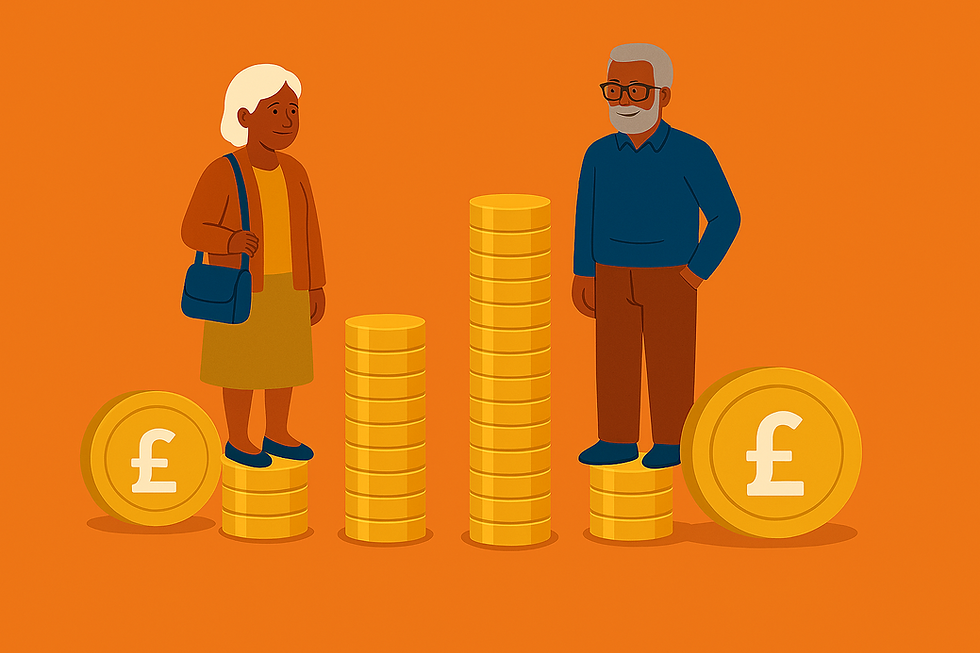Creating the perfect team - Getting the diversity and balance right
- Emily Adlington

- May 20
- 4 min read
Updated: Jul 8
Our panel, Teagan Robinson-Bell, Dan Macpherson, Angeli Ganoo-Fletcher, Carlene Goodearl and Mathilde Guttard
Building inclusive teams: Insights from the WiRL webinar on diversity
Our latest webinar brought together a range of voices from across the built environment and later living sectors to examine what genuine inclusion looks like, and how to embed it meaningfully across organisations.
Hosted by Carlene Goodearl, senior development manager at Rangeford Villages, the session aimed to explore how diverse, equitable, and inclusive workplaces can lead to better decisions, stronger teams, and improved outcomes for the communities they serve.
The panel featured speakers from across the industry, each bringing a unique lens: Mathilde Guttard from Octopus Real Estate, Angeli Ganoo-Fletcher from PRP, Dan Macpherson from TSA Riley, and Teagan Robinson-Bell from Anchor. The conversation touched on lived experience, organisational culture, inclusive leadership, allyship, and accountability.
Representation matters, but it’s just the start
Mathilde Guttard, an investment director at Octopus Real Estate, highlighted how diversity directly supports decision-making and resilience in investment strategy:
“A good example in investment is that we are managing risk. The best way to manage risk is to have people who bring different views, different backgrounds, different experiences. That’s how you get really good decisions, and how you build the best teams.”
Her point resonated with others on the panel, particularly the idea that visible representation must be paired with genuine empowerment. Diversity without inclusion, she noted, is not enough.
Teagan Robinson-Bell, diversity and inclusion manager at Anchor, was equally clear about the tangible impact of diverse teams:
“When we have diverse teams, we automatically get better results for customers. We understand them better, we innovate more effectively, and we make better decisions. You simply can’t deliver great service without a team that reflects the people it’s serving.”
She added that diversity fosters credibility and trust with the communities an organisation is trying to support. If customers don’t see themselves reflected in service providers, it affects their confidence and engagement.
Culture, not just compliance
Several speakers warned against the “tick-box” approach to diversity. True inclusion, they stressed, goes beyond hiring and policies, it must be baked into the culture.
Angeli Ganoo-Fletcher, a director at PRP and a landscape architect with over 25 years’ experience in the construction industry, explained:
“You can’t just hire diverse people and stop there. You have to create an environment where everyone feels psychologically safe, where they can thrive, speak up, and know they’ll be heard.”
That sense of safety and belonging was a recurring theme. Inclusion, the panel agreed, means designing team dynamics that make people feel they’re not only welcome, but expected to contribute fully.
The role of allyship
Dan McPherson, executive director at TSA Riley and head of later living, spoke about his experience as a male ally and the importance of supporting underrepresented voices:
“As a male ally, I’ve learned how powerful it is to create space for others. Inclusion is everyone’s responsibility, and that starts with listening.”
Dan also highlighted the need to build inclusive talent pipelines. His organisation focuses on early careers, apprenticeships, and non-traditional routes into the industry as part of a broader effort to diversify leadership from the ground up.
Calling out bias, and calling others in
Throughout the webinar, speakers shared personal stories of exclusion and microaggressions, such as being the only woman or person of colour in a room, or having ideas overlooked until voiced by someone else. These moments were not just anecdotes but calls to action.
“We’ve all got bias,” said Teagan. “The important thing is whether we’re doing the work to unlearn it.”
She encouraged attendees to speak up when they see bias at play, and to create space for difficult conversations. Mathilde added, “It’s not always comfortable. But when you share your truth, you give others permission to do the same.”
Designing for everyone
The conversation also extended to the physical spaces teams create, particularly important in the later living sector. Angeli pointed to the importance of inclusive placemaking:
“Designing environments that meet diverse needs starts with listening. We need planners, architects, and developers who understand lived experience, not just technical specifications.”
Inclusive design, she explained, means considering everything from mobility and sensory needs to cultural expression and intergenerational spaces.
Moving the conversation forward
As the session came to a close, Carlene encouraged attendees to view diversity and inclusion as an ongoing commitment, not a one-off exercise.
“We can’t afford to get comfortable. We need to challenge ourselves to do better, for our teams, our customers, and our communities.”
The panel’s collective message was clear: inclusive teams are not only fairer, but also more effective, more resilient, and more aligned with the communities they serve. And while progress has been made, there is still much work to do.
Key takeaways
Representation must be meaningful: It’s not enough to have diversity on paper, real inclusion means sharing power and creating psychological safety.
Inclusive teams perform better: Diverse teams make better decisions, deliver stronger services, and build trust with customers.
Culture matters more than policy: Inclusion should be embedded into team dynamics, leadership behaviours, and everyday decisions.
Allyship is essential: Everyone, especially those in positions of privilege, has a role to play in amplifying underrepresented voices.
Bias must be challenged: Speaking up against microaggressions and systemic inequality is part of building better organisations.
Inclusive design starts with listening: Physical spaces, like teams, should be built with real users in mind, from accessibility to belonging.














Comments